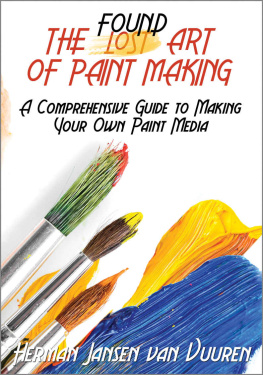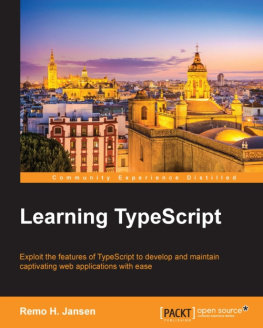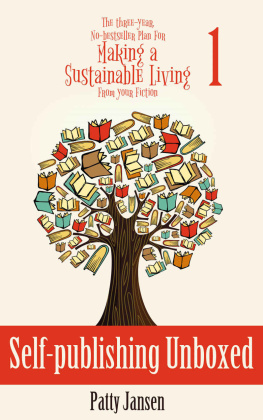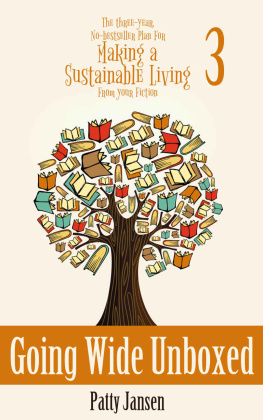Herman Jansen Van Vuuren - The Found Art of Paint Making
Here you can read online Herman Jansen Van Vuuren - The Found Art of Paint Making full text of the book (entire story) in english for free. Download pdf and epub, get meaning, cover and reviews about this ebook. genre: Children. Description of the work, (preface) as well as reviews are available. Best literature library LitArk.com created for fans of good reading and offers a wide selection of genres:
Romance novel
Science fiction
Adventure
Detective
Science
History
Home and family
Prose
Art
Politics
Computer
Non-fiction
Religion
Business
Children
Humor
Choose a favorite category and find really read worthwhile books. Enjoy immersion in the world of imagination, feel the emotions of the characters or learn something new for yourself, make an fascinating discovery.
- Book:The Found Art of Paint Making
- Author:
- Genre:
- Rating:5 / 5
- Favourites:Add to favourites
- Your mark:
- 100
- 1
- 2
- 3
- 4
- 5
The Found Art of Paint Making: summary, description and annotation
We offer to read an annotation, description, summary or preface (depends on what the author of the book "The Found Art of Paint Making" wrote himself). If you haven't found the necessary information about the book — write in the comments, we will try to find it.
The Found Art of Paint Making — read online for free the complete book (whole text) full work
Below is the text of the book, divided by pages. System saving the place of the last page read, allows you to conveniently read the book "The Found Art of Paint Making" online for free, without having to search again every time where you left off. Put a bookmark, and you can go to the page where you finished reading at any time.
Font size:
Interval:
Bookmark:
found
THE LOST ART
OFPAINT
MAKING
A Comprehensive Guide to making
Your own Paint Media

HermanJansen van Vuuren
Textand photographs Copyright 2013 Herman Jansen van Vuuren. The rights of HermanJansen van Vuuren to be identified as the author of this work have beenasserted by him in accordance with the Copyright, Designs and Patents Act,1988.
Apart from any fair dealing for the purposes of researchor private study, criticism or review, as permitted under the Berne Conventionin terms of the Copyright, Designs and Patents Act, (Act 98 of 1988), thispublication may be reproduced, stored or transmitted, in any form or by anymeans, only with the prior permission of the author.
The first edition published by H-Art Press (ISBN-13:978-0-9576289-0-8)
ISBN-13: 978-1541118089
ISBN-10: 1541118081
This book isdedicated to the memory of my father
Gert G. Jansen vanVuuren.
CONTENTS
There is a growing need amongstserious professional artists and students to know more about the compositionand properties of the art media that they utilise in the creative process. Thisresults from the curiosity of contemporary artists to explore alternatives totraditional materials and techniques. In order to be able to experiment withnew and unconventional materials a basic knowledge of traditional conventionsis a necessity. An understanding of the properties and characteristics oftraditional art media and processes will equip the artist with knowledge thatwill enable him/her to develop new possibilities founded on stable and testedprinciples. The high cost of commercially prepared art materials has been amajor influence in the artists on-going quest to find reasonable substitutes.
This book provides artists with thebasic knowledge to experiment freely and produce their own media at a fractionof the cost of premixed commercial products. Apart from these benefits itencourages painters to enjoy the process of mixing the magical substances thatbecome part of that wonderful creative process - the art of painting.
Koos van der Watt
Department of Fine Arts,
University of South Africa
Pretoria
The origins of modern art can betraced far back in the history of humanity. The abstractions of human forms inAfrican cave paintings and that of the Egyptians have without a doubtinfluenced modern painting. The pioneering efforts of the great artists such asCzanne, Matisse and Picasso, taught the modern artists that the rigid rules ofexpression had changed, and that the limitations of these rules could now beshed. One of these results was a revolutionary way of thinking and seeing whichgave birth to amazing creative energy that has resulted in many important worksof art in this century.
Along with new ways of preparingpaintings, there came the idea that the concept and the process of therealisation of the work was more important than the final work produced,whether or not it self-destructed was and appears of no concern to someartists. If it were not for the idea, the painting would have no meaning. Thisis surely undeniable, but there is something very discouraging about seeing anidea lose its meaning because the artist forgot, or ignored, the tradition ofsound craftsmanship which has a direct bearing on the permanence of theartwork.
The trend toward the disintegrationof practical information about artist materials began with the industrialrevolution. This new world had neither time nor patience for the traditionalmethod of transmitting knowledge orally from master to apprentice.Consequently, a great deal of information was lost. Colleges and universitieswith art programmes not only did nothing to reverse this trend but alsofostered it by emphasising the philosophical and conceptual side of art overthe practicalities of producing it.
The ABC television series Nightlinedevoted thirty minutes to the subject of the impermanence of contemporary art.On this program, Larry Rivers explained that the reason for this problem isthat information about contemporary materials does not seem to be part of arteducation... No one told me that tape eats paper and I used it for years.Virtually all institutions, schools, and universities that offer art programstoday provide no formal background in materials. The need for this kind oftraining has, however, become increasingly evident, as more and more money isinvested in Artists materials and in collecting art. Sothebys estimates thatas much as four hundred billion dollars worth of art is held in privatecollections, twenty-five billion dollars of which is sold each year. In 1986,Sothebys sold Out of the Window by Jasper Johns for more than three and ahalf million dollars, setting a record for a work by a living artist.
The artist needs to realise that whenthey prepare their own paints, they have the potential for greater control andvariety of effects that are not possible with commercially manufactured paints.Manufacturers have to prepare a product that will have a shelf life of at least2 years. To achieve this, it is necessary for stabilisers to be used, therebyadding a higher percentage vehicle than would be needed if the paint were usedimmediately. The artists who prepare their own paints can make any combinationof paints that suit their preference and customise them.
By mixing their own paints, artistsare able to save a substantial amount on the cost of materials. When ready-madeproducts are bought, savings often have to be sacrificed for convenience.
For the teacher in particular, thereis yet another reason for having students make their own materials with whichthey work. This is the best way for them to know and understand the chemistryand nature of the materials, by actually using them.
Art is quite effectively related toliterature and the social sciences but very seldom with physical sciences. Thisis unfortunate as most artists and students make fundamental errors inpainting, which can be avoided if they are better informed regarding thechemistry and correct function of materials in painting. The knowledge thatthey gain can prepare them to be more enlightened consumers of ready-madeproducts and can make it possible for them to improvise if certain materialsare not available.
When exploring a variety oftraditional media and by preparing their own materials in much the same way asartists working in pre-industrial times made them, students often realise a fargreater appreciation of works produced by artists in earlier times.
When an artist prepares his/her ownpaints the creative control is far greater than that of just using normalartists grade store bought paints. This allows for more of the artistsindividuality to have its way from the very onset of the birth of the paint. Itis a known fact that when an artist sympathises with his medium that somehowmysteriously the medium returns the favour. The example can be found especiallyin sculpture. The creative process starts at this stage, which has for manyyears been looked upon as a mundane exercise, but was one of the secrets of thegreat masters.
Professional integrity and fine artdoes not seem to find common ground with some of todays contemporary artists.Whilst lecturing about artist materials at a prominent university, I heard alecturer mention that one of his Fine Art students created an artwork that wasone of the best he had seen (the lecturer that is), but he would not accept itfor marking as it was in the process of falling off the canvas. Imaginecreating the absolute best painting in your life and it falls apart in front ofyou. What an absolute shame it would be if the Masters of the past had todaysattitude. I once heard an artist remark that he never varnishes his paintings;he doesnt see the need for it. Would you buy a car that was unpainted, and wasjust bare metal without even a primer on it? Of course you would not; it wouldrust away within weeks!
Next pageFont size:
Interval:
Bookmark:
Similar books «The Found Art of Paint Making»
Look at similar books to The Found Art of Paint Making. We have selected literature similar in name and meaning in the hope of providing readers with more options to find new, interesting, not yet read works.
Discussion, reviews of the book The Found Art of Paint Making and just readers' own opinions. Leave your comments, write what you think about the work, its meaning or the main characters. Specify what exactly you liked and what you didn't like, and why you think so.






